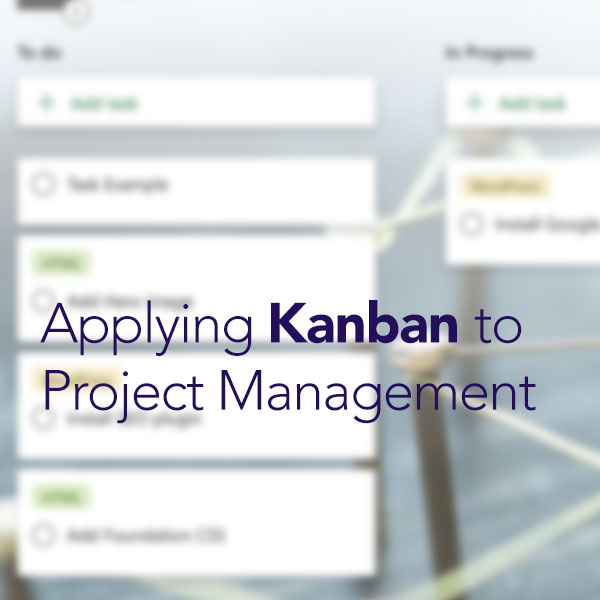
by Patrick Villanueva, Technology Instructor and Media Lab Assistant
5/3/21
To help organize current projects and tasks, I wanted to use a Kanban application. It helps me get into a good workflow, and I was happy to see it applied to Microsoft Planner. Here at the Lake Forest Library, we are Office 365 users and I wanted to see if there was an equivalent to Trello - a Kanban application and something I would've used had I not found anything similar in the Office suite.
What is Kanban?
From my own perspective: It's a way to visualize tasks involved in projects, comprised of boards and cards. You can assign tasks to others on cards, put due dates and notes on them. At a previous workplace, we dragged cards from one column to the next as a means to show progress. It was pretty straightforward. We took a card with a particular task in a "to do" column, placed it into another column that denoted "work in progress," and dragged it to the "completed" column when finished. It's a great collaborative tool, as each person on the team can view these boards. Below is a basic example.
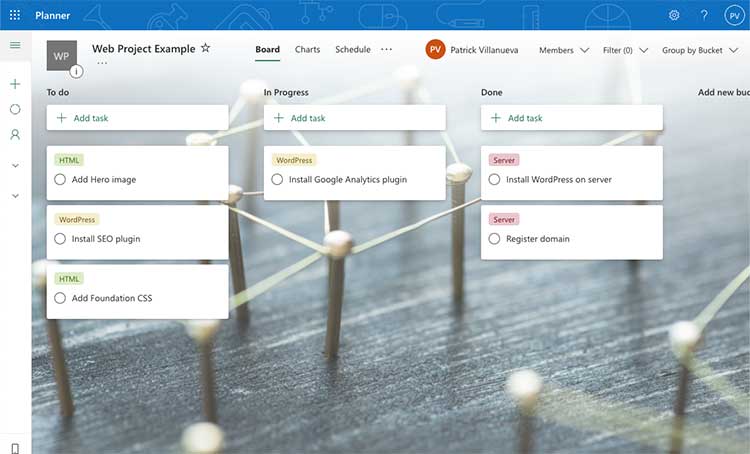
Kanban is especially popular with software companies that have adopted the Lean Method/Thinking and agile methodologies. To paraphrase Wikipedia, Kanban is Japanese for signboard or billboard and "aims to manage work by balancing demands with available capacity and improving the handling of system-level bottlenecks."
History
Kanban was derived from Toyota back in the late 1940s. One of their industrial engineers, named Taiichi Ohno, developed Kanban to improve manufacturing efficiency. Microsoft Engineer, David J. Anderson, realized that this process was applicable to any company in need of organization. According to kanbanize.com, this turned into what is accepted as the Kanban Method in 2007.
David J. Anderson developed the process to be focused on getting things done, and its fundamentals boil down to four core principles and six practices.
The 4 Core Principles
-
Start with what you do now. This allows you to transition slowly to a new type of workflow as opposed to being a complete shift.
-
Agree to pursue incremental, evolutionary change. This is implemented to address resistance from team members.
-
Respect the current process, role and responsibilities. This is meant to retain value of previous practices and establishments, and also provides a path for incremental change.
-
Encourage acts of leadership at all levels. Leadership comes from the people who are working that front line, not necessarily management. Optimal performance can be achieved adopting Kaizen, a continuously improving mindset.
The 6 Practices
-
Visualize the workflow. The image above is one of the most basic of examples.
-
Limit work in progress. There's a limit to WIP items, as more multitasking will only create more inefficiency.
-
Manage flow. The focus here is the movement of work, not people, to optimize work and create value faster.
-
Make process policies explicit. Team members need to be on the same page.
-
Feedback loops. Implement meetings, called stand ups, at the start of the workday to synchronize with other team members. Various reviews should also be held at regular intervals.
-
Improve collaboratively. A shared understanding of goals, processes, etc. of a better future will contribute to this.
How to Use Microsoft Planner
When it comes to using any type of project managing software, organizing your data or info is really up to you. Again, Kanban boards typically have the columns: 1) to do items; 2) tasks in progress; and 3) completed. You could organize items according to category to further aid in breaking down projects. They're also done using Swimlanes, but they are not implemented in Planner. In the example above, I used label colors to categorize tasks.
Kanban are comprised of boards and cards. Boards can be thought of as one project, and cards are all the tasks involved. Microsoft Planner refers to their boards as Plans. To start a new plan, click on "New plan" to the left. Smaller browser widths may only show a + sign, which you can also click. Both are highlighted in yellow below.
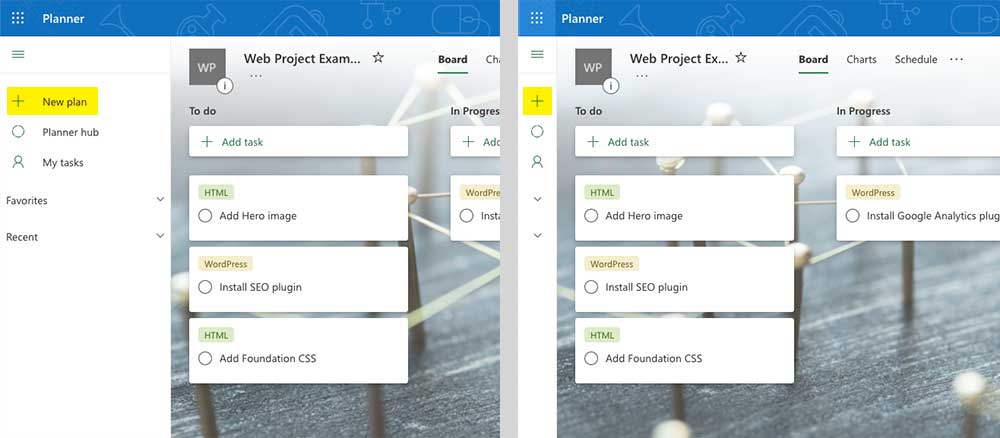
A popup will appear after making a new plan.
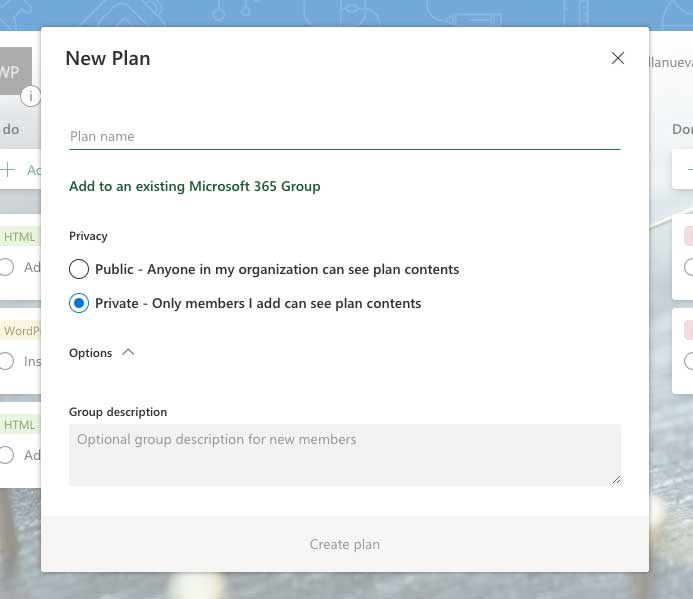
Enter a Plan name in the prompt, choose Privacy setting, optionally enter a Group description if you'd like, and finally click on Create plan. By default, you will only have two columns (called buckets in Microsoft Planner) To do and Add new bucket. You can dump all tasks in the To do bucket, and create other buckets like In Progress and Completed.
You can add more members underneath the members section as needed.

To create a new bucket, click on Add new bucket to the right of the last bucket/column and enter a name. There's nothing more to it. The picture is referencing the previous example.
Similar to how Plans are Boards, Microsoft Planner refers to Tasks as cards. To add a new task, you can simply click on Add task under the appropriate bucket. Click on Add Task, enter a name for the task, optionally add a due date and/or assign the task, and finally press enter/return (or click on the Add Task button) to commit the new task. To add more info (or edit), you can double-click on the Task. A popup will appear, in which you can change data as needed.
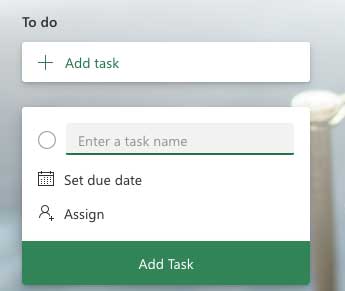
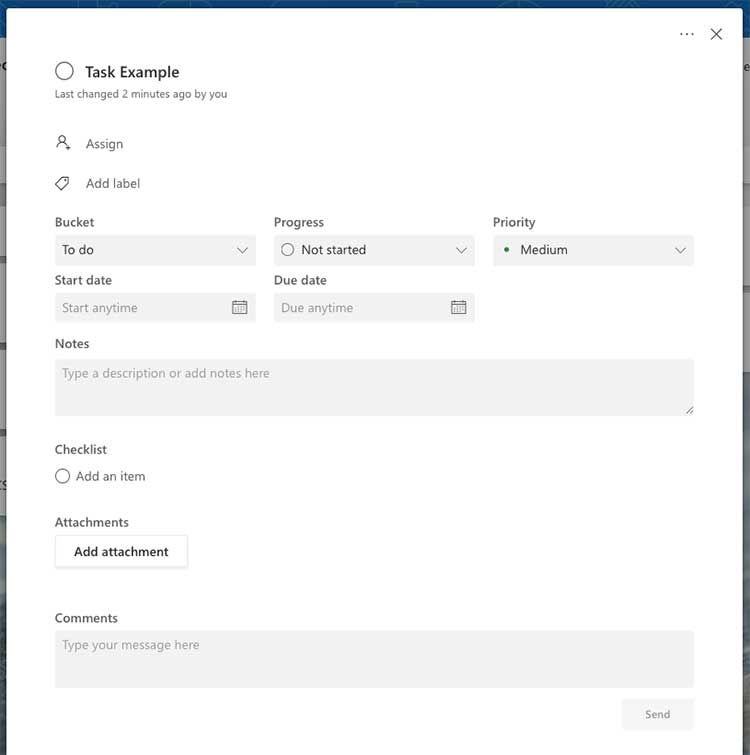
When assigning tasks to a particular Team member, that task will show under My tasks in the submenu to the left.
Again, you can use labels as a means to categorize tasks. Tasks can be dragged from one bucket/column to the next, simply by clicking and dragging them.
The basics of Kanban and Microsoft Planner aren't too complicated. It's more about getting used to this kind of workflow. Again, assess efficiency and work towards optimizing it, especially by limiting things like Work in Progress.
Alternatives
Again, Trello is a very popular application that uses Kanban. Others include Jira and AirTable.
If you have any questions, you can email me at MediaLab@lakeforestlibrary.org. The Media Lab is still closed to the public, but please feel free to make a virtual appointment by visiting lakeforestlibrary.org/medialab. It's just me at the Media Lab now, but I'd be happy to help with your digital projects.
Until next time, please stay healthy and safe!